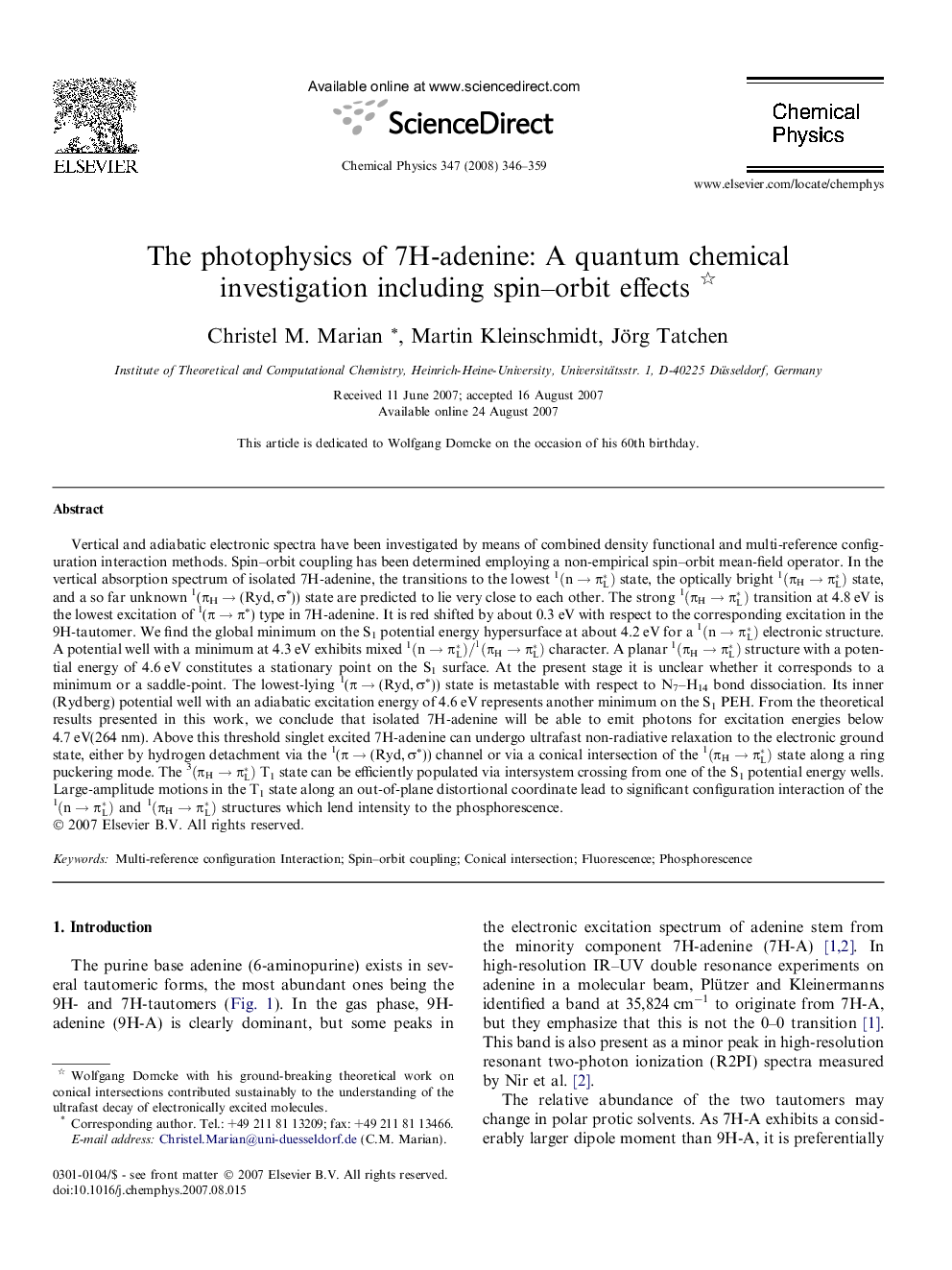| کد مقاله | کد نشریه | سال انتشار | مقاله انگلیسی | نسخه تمام متن |
|---|---|---|---|---|
| 5375900 | 1504311 | 2008 | 14 صفحه PDF | دانلود رایگان |
عنوان انگلیسی مقاله ISI
The photophysics of 7H-adenine: A quantum chemical investigation including spin-orbit effects
دانلود مقاله + سفارش ترجمه
دانلود مقاله ISI انگلیسی
رایگان برای ایرانیان
کلمات کلیدی
موضوعات مرتبط
مهندسی و علوم پایه
شیمی
شیمی تئوریک و عملی
پیش نمایش صفحه اول مقاله

چکیده انگلیسی
Vertical and adiabatic electronic spectra have been investigated by means of combined density functional and multi-reference configuration interaction methods. Spin-orbit coupling has been determined employing a non-empirical spin-orbit mean-field operator. In the vertical absorption spectrum of isolated 7H-adenine, the transitions to the lowest 1(nâÏLâ) state, the optically bright 1(ÏHâÏLâ) state, and a so far unknown 1(ÏH â (Ryd, Ïâ)) state are predicted to lie very close to each other. The strong 1(ÏHâÏLâ) transition at 4.8 eV is the lowest excitation of 1(Ï â Ïâ) type in 7H-adenine. It is red shifted by about 0.3 eV with respect to the corresponding excitation in the 9H-tautomer. We find the global minimum on the S1 potential energy hypersurface at about 4.2 eV for a 1(nâÏLâ) electronic structure. A potential well with a minimum at 4.3 eV exhibits mixed 1(nâÏLâ)/1(ÏHâÏLâ) character. A planar 1(ÏHâÏLâ) structure with a potential energy of 4.6 eV constitutes a stationary point on the S1 surface. At the present stage it is unclear whether it corresponds to a minimum or a saddle-point. The lowest-lying 1(Ï â (Ryd, Ïâ)) state is metastable with respect to N7-H14 bond dissociation. Its inner (Rydberg) potential well with an adiabatic excitation energy of 4.6 eV represents another minimum on the S1 PEH. From the theoretical results presented in this work, we conclude that isolated 7H-adenine will be able to emit photons for excitation energies below 4.7 eV(264 nm). Above this threshold singlet excited 7H-adenine can undergo ultrafast non-radiative relaxation to the electronic ground state, either by hydrogen detachment via the 1(Ï â (Ryd, Ïâ)) channel or via a conical intersection of the 1(ÏHâÏLâ) state along a ring puckering mode. The 3(ÏHâÏLâ) T1 state can be efficiently populated via intersystem crossing from one of the S1 potential energy wells. Large-amplitude motions in the T1 state along an out-of-plane distortional coordinate lead to significant configuration interaction of the 1(nâÏLâ) and 1(ÏHâÏLâ) structures which lend intensity to the phosphorescence.
ناشر
Database: Elsevier - ScienceDirect (ساینس دایرکت)
Journal: Chemical Physics - Volume 347, Issues 1â3, 23 May 2008, Pages 346-359
Journal: Chemical Physics - Volume 347, Issues 1â3, 23 May 2008, Pages 346-359
نویسندگان
Christel M. Marian, Martin Kleinschmidt, Jörg Tatchen,